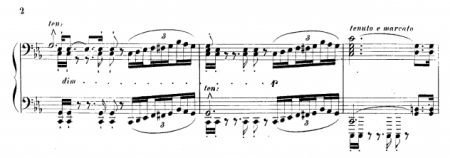
As it’s Sunday, let’s have a religious topic (adage), and an extra confession: So help me God, I hate slow music. I don’t have the patience to listen to it, and I get bored playing it. The music example above – a fragment of Siegfried’s Death and Funeral March from Wagner’s Götterdämmerung – is for me the epitome of the kind of music that should never have been conceived, written down, or performed. I’d rather be stuck in traffic than wait for the next semiquaver. If you like this kind of thing, that’s fine. But as someone who (I’m pretty sure, although it’s not diagnosed) has adult attention deficit disorder, unless there’s more going on in the music than in my brain, I get bored and distracted (I also just don’t like Wagner’s music at all, but that’s another story).
That’s why I find adage excruciating to play for. I don’t want to see it, and I don’t want to accompany it. All I’m thinking is “how long til allegro?” It’s exhausting having to hold yourself back from every quaver, like walking in slow motion. Occasionally, people say “Oh I love it when you play that for adage” and I have to smile and pretend that I love it too, whereas I can almost guarantee that I don’t enjoy playing anything that’s slow. For one thing, if I’m feeling down, my brain has time to wander and get miserable in the space between the notes.

There’s are a few exceptions, and one of them is the Prelude to La Traviata (above). Apart from the fact that it’s got a nice tune, it’s also got all those fast notes going on in the right hand against the slow tune in the left that mitigates the slowness, and gives you enough to concentrate on while you play to stop your mind from wandering. Nothing against adage or slow music, or the people who like it, but for me, I’d rather keep moving. Sadly, I discovered a couple of years ago that this wonderful piece is used for Adage in one of the Cecchetti syllabuses, and so may need a trigger warning for some dancers.
Maybe this is why I enjoy playing for dance. At the tempo of the Wagner example at the top of this post, you begin to lose any sense of beat or metre (see paragraph 2 in Justin London’s article about metre perception, I’m not making it up). For some people, this is what they like about music – the opportunity to get lost in it, to lose sense of time passing. For me, it’s reading that has that effect on me, and I can easily get lost in a book, and enjoy the sensation. Music has to move.


Was playing the Prelude torture then? It certainly didn’t sound like it!! For you it must be even worse than normal adage in that each repetition (Markova version) is supposed to be slower than the previous one 🙂
In the sense that it needed enormous concentration to keep in time, yes. At that speed, it’s very hard to maintain the rhythm without mentally subdividing each beat into at least four for the duration of the piece, and counting like crazy – you have to be your own conductor, as well as performer, whereas at faster speeds, the rhythm carries you along once the beat has been set up.
But as I was writing that post, I knew that there were exceptions, and I’d put the Prelude (at least when you were dancing it) as one of them. For one thing, the slowness of the music creates atmosphere, it’s not just ratcheting down the metronome to a mechanically correct speed. There’s also big difference between slow music in performance for a solo like the Prelude, where the choreography has a rhythm and articulation of its own that might be at counterpoint to the music, and slow music in class for a group of tired people all trying to regulate their body in a slow way for the sake of some future outcome. The danger point for me is lack of stimulation, so the more things there are to fill the gaps, like interesting choreography, exceptional dancing, lighting, costume, an audience, nerves and so on, the less slow music is torture.
I think adages where there are fast notes ‘holding the melody together’ are good for dancing to because they remind us to keep our ‘support muscles’ working throughout the exercise instead of flopping around. Elsewhere in the class, I am fond of 4/4’s that have a continuous ‘hum’ of fast notes for exercises where I want to emphasize controlled and flowing movement. For this reason, I’m not very keen on syncopated music for tendus, fondus and the like. Boring maybe, but functional, I believe for high level students who are still honing their technique.
Thanks for the very helpful comment. I’ve built up most of what I know/think about from the extremely rare occasions when people like you give a rationale for doing one thing rather than another. It doesn’t matter that not everyone will agree: It gives you somewhere to start from when thinking about music for an exercise, which is vital.
I played Chopin’s Nocturne in F minor yesterday for adage, and I found that horrible. I couldn’t help but fill the gaps on my left hands with notes. As if between every quarter note people were not dancing but just holding their bodies in one position
By the way, thanks for this wonderful blog, it’s nice to share for a rather lonely job.
Bruno (ballet pianist from Paris)
Oh I know that feeling with that piece! Thanks for the nice words about the blog – glad you like it.